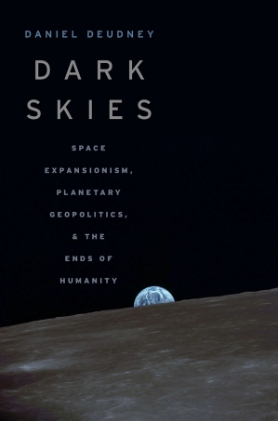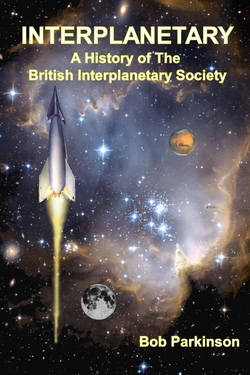Centauri Dreams
Imagining and Planning Interstellar Exploration
IRS 63: How Quickly Do Planets Form?
I’m startled by the findings in a new paper from Dominique Segura-Cox (Max Planck Institute for Extraterrestrial Physics), who argues that based on the evidence of one infant system, we may have planet formation all wrong, at least in terms of when it occurs. The natural assumption is that the star appears first, the planets then accruing mass from within the circumstellar disk. But Segura-Cox and team have found a system in which planet and star seem to be forming all but simultaneously. IRS 63 is a protostar about 470 light years out that is less than half a million years old. Swathed in gas and dust, the star is still gathering mass, but evidence from the disk suggests that the planets have already begun to form.
One reason for the surprise factor here is that we’ve looked at many young stellar systems and their disks, most of them at least one million years old, and the assumption has been that the stars were well along in their own formation process before the planets began to build. Ian Stephens (Center for Astrophysics | Harvard & Smithsonian), a co-author on this paper, is quite clear on the matter: “Traditionally it was thought that a star does most of its formation before the planets form, but our observations showed that they form simultaneously.”
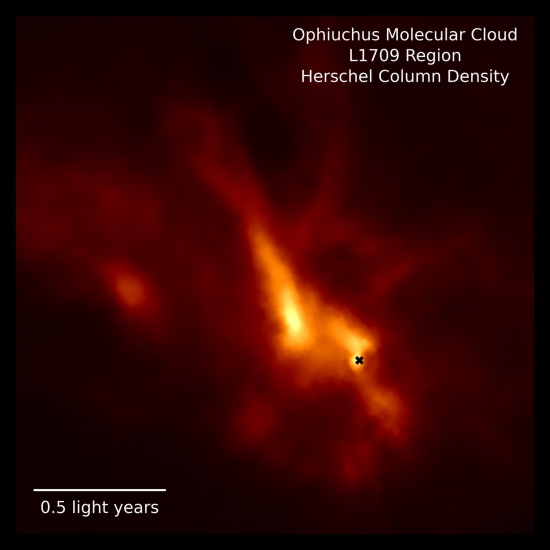
Image: The dense L1709 region of the Ophiuchus Molecular Cloud, mapped by the Herschel Space Telescope, which surrounds and feeds material to the much smaller IRS 63 proto-star and planet-forming disk (location marked by the black cross). Credit: MPE/D. Segura-Cox; Herschel data from ESA/Herschel/SPIRE/PACS/D. Arzoumanian.
Planets and host star as siblings? It takes a bit of getting used to, but the Segura-Cox team is finding gaps and rings, the rings accumulating dust suitable for planet formation, within the IRS 63 disk. The paper summarizes earlier disk observations at other stars, where the gaps and rings found in the disks have generally appeared in so-called Class II disks with ages of one million years or more — ALMA (Atacama Large Millimeter/submillimeter Array) has turned up more than 35 of these — with gaps showing little or no dust emission, a fact usually explained by a planet-mass object shaping the dust into rings.
Fitting IRS 63 into this picture, we get this:
These results indicate that planet formation must be both efficient and well underway by the class II phase. Recent dust mass measurements of class II disks also indicate that observed dust depletion could be explained if substantial mass is locked into planetesimals on timescales less than 0.1-1 Myr, placing early planet formation into the younger class I phase and possibly even earlier. In comparison to the rings and gaps found in the older disks of class II objects, the annular substructures in the younger disk of IRS 63 have dust emission even in the G1 and G2 gaps and are wider and have lower contrast. In IRS 63, it is unclear whether or not sizeable planetary-mass bodies are creating these gaps.
Stephens estimates that planets start to form as early as the first 150,000 years of a system’s formation, at the earliest stages of star growth. If each of the gaps at IRS 63 is opened by a single planet, the authors estimate the first gap (G1) would require a planet of 0.47 Jupiter mass, while the second gap (G2) demands 0.31 Jupiter mass, both numbers being upper limits.
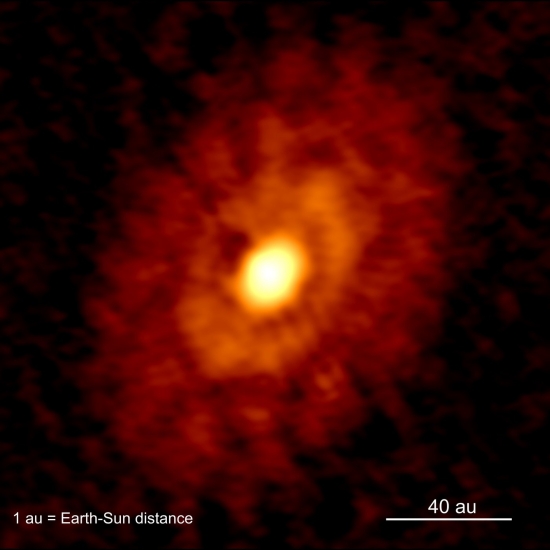
Image: The ALMA image of the young planet-forming dust rings surrounding the IRS 63 proto-star, which is less than 500,000 years old. Credit: MPE/D. Segura-Cox.
The paper notes that Jupiter is an interesting world in this kind of scenario. The disk at IRS 63 is similar in size to our own Solar System, and the mass of the proto-star not far off that of the Sun. Such early formation implies a distant new planet migrating into its present position:
For a planetary embryo made of solids to trigger runaway accretion of gaseous material—required in the core-accretion model of gas-giant planet formation—the critical mass of 10MEarth must be met by the solid core. This condition is readily met in the young IRS 63 disk, even for a somewhat low efficiency (<10%) of core formation out of the available dust grains. The large dust mass in the outer dust disk—combined with the 27 and 51 au radii of the rings of IRS 63—is consistent with evidence that Jupiter’s core could have formed beyond 30 au in our own Solar System and later migrated inward. Giant-planet cores may often form in the exterior regions of large disks starting from the early phases of star formation.
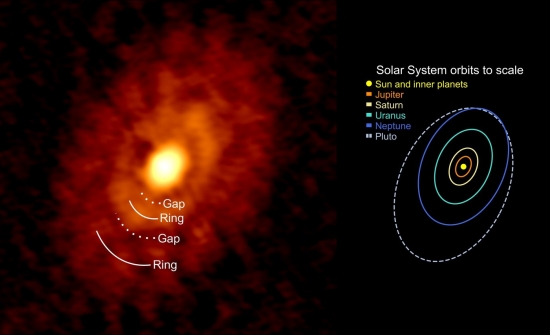
Image: The rings and gaps in the IRS 63 dust disk compared to a sketch of orbits in our own Solar System at the same scale and orientation of the IRS 63 disk. The locations of the rings are similar to the locations of objects in our Solar System, with the inner ring about the size of the Neptune orbit and the outer ring a little larger than the Pluto orbit. Credit: MPE/D. Segura-Cox.
At IRS 63, the researchers find that about 0.5 Jupiter masses of dust are available at distances beyond 20 AU, along with unspecified amounts of gas. Planet formation at large distances from the star might involve solid material totalling at least 0.03 Jupiter masses, forming the kind of planetary core that can accrete gas and swell into a gas giant planet.
The paper is Segura-Cox, et al., “Four annular structures in a protostellar disk less than 500,000 years old,” Nature Vol. 586 (7 October 2020), pp. 228-231 (abstract).

M-dwarf Superflares and Habitability
We could use a lot more information about flare activity on M-dwarf stars, which can impact planetary atmospheres and surfaces and thus potential habitability. Thus far much has been said on the subject, but what has been lacking are details about the kinds of flares in question. It’s a serious issue given that, in order to be in the liquid water habitable zone, an M-dwarf planet has to orbit in breathtaking proximity to the host star.
Flares occur through a star’s magnetic field re-connection, which releases radiation across the electromagnetic spectrum. While flares can erode atmospheres and bathe the surface in UV flux, too few flares could actually be detrimental as well, providing as a new paper on the matter suggests, “insufficient surface radiation to power prebiotic chemistry due to the inherent faintness of M-dwarfs in the UV.”
The paper is out of the University of North Carolina, measuring a large sample of superflares in search of a clearer picture of their effect. Flares on the Sun are common enough, as witness the image below, shot in 2012, which shows the kind of coronal mass eruption (CME) associated with stellar flaring. At young M-dwarfs, we can get ‘superflares’ in energy ranges 10 to 1,000 times larger than our Sun provides, bathing a nearby planet in intense ultraviolet light.
“We found planets orbiting young stars may experience life-prohibiting levels of UV radiation, although some micro-organisms might survive,” says lead study author Ward S. Howard.
Or could flares be a driver of evolution? Just how much is too much when it comes to flaring?
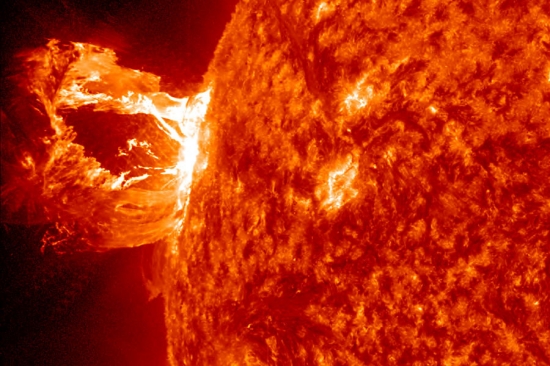
Image: A beautiful prominence eruption producing a coronal mass ejection (CME) shot off the east limb (left side) of the sun on April 16, 2012. Such eruptions are often associated with solar flares, and in this case an M1 class (medium-sized) flare occurred at the same time, peaking at 1:45 PM EDT. The CME was not aimed toward Earth. The eruption was captured by NASA’s Solar Dynamics Observatory in the 304 Angstrom wavelength, which is typically colored in red. Credit: NASA/SDO/AIA.
Howard’s team used data from TESS, the Transiting Exoplanet Survey Satellite, coupled with observations from the university’s Evryscope telescope array, to make the study. Previous flare work has homed in on a relatively small number of stars in terms of flare temperatures and radiation flux. Using the largest sample of superflares ever studied in terms of temperature, the new study finds it predictive of the amount of radiation that is likely to reach a planetary surface. A statistical relationship emerges between the size of a superflare and its temperature.
Superflares are not long-lasting events, emitting most of their UV in a rapid peak that may last between 5 and 15 minutes. The TESS data, taken simultaneously with the Evryscope observations, were obtained at a two-minute cadence for 42 superflares from 27 K5-M5 dwarfs. The work extends the range of our observations, while simultaneously playing into the potential target list for the James Webb Space Telescope.
The authors note that flare emissions have usually been approximated by a 9000 K blackbody (a surface that absorbs all radiant energy falling on it). But if superflares are hotter than this, the UV emission may surge by a factor of 10 higher than would otherwise be predicted through optical observation. Only a handful of multi-wavelength observations over short periods of time have been performed, and the TESS/Evryscope work doubles the total number found in the literature, helping us understand how temperature evolves in M-dwarf superflares. 43% of the superflares studied emit above 14,000 K, 23% above 20,000 K and 5% above 30,000 K, with the hottest one observed briefly reaching an incandescent 42,000 K.
We’re dealing, in other words, with a lot of UV flux here, particularly the dangerous ultraviolet C (UV-C) wavelength. From the paper, which takes note of a 2016 superflare observed at Proxima Centauri:
If HZ planets orbiting <200 Myr stars typically receive ?120 W m?2 and often up to 103 W m?2 during superflares, then significant photo-dissociation of planetary atmospheres may occur (Ribas et al. 2016; Tilley et al. 2019). As a point of comparison, the likely water loss of Proxima b is due to the long-term effects of a time-averaged XUV flux (including flares) of less than 1 W m?2 (Ribas et al. 2016). The median value from the flares observed in YMGs [young moving group stars] is comparable to the ?100 W m?2 of UV-C flux estimated at the distance of Proxima b during the Howard et al. (2018) Proxima superflare. While Abrevaya et al. (2020) found 10?4 microorganisms would have survived the Proxima superflare, it is presently unclear what effects a 10× increase in UVC flux would have on the evolution and survival of life prior to 200 Myr; it is possible such high rates of UV radiation could drive pre-biotic chemistry (Ranjan et al. 2017; Rimmer et al. 2018), suppress the origin of life on worlds orbiting young M-dwarfs (Paudel et al. 2019), or not impact astrobiology at all if the timescale for life to emerge is longer than 200 Myr (Dodd et al. 2017; Paudel et al. 2019).
Addendum: Alex Tolley makes a solid point about this material in the context I gave it. Let me quote him:
“The extract starting with:
“If HZ planets orbiting <200 Myr stars typically receive
~120 W m-2”
does not make it clear that the flux is for UV, not total output. Only the low values (compared to Earth) and the later inclusion of “UV” allows the reader to infer that this is only the UV flux. In the paper, this section is prefaced by some text that talks about UV and makes the next paragraph clearer. For readers like me, not steeped in stellar knowledge, this could be clearer.”
Exactly so, and I appreciate the note, Alex. — PG
Three of the stars targeted in this study, the aforementioned Proxima Centauri, LTT 1445 and RR Cac AB are already known to host planets. And what of the age difference between young M-dwarfs and their presumably more sedate elder cousins? Should we preferentially target older M-dwarfs? The authors argue that it’s too early to make a call:
Although higher-mass young M-dwarfs may emit more biologically-relevant UV flux as a consequence of frequent superflares than do lower-mass young M-dwarfs, we do not confirm that more UV-C flux from early M-dwarf superflares consistently reaches the HZ. The relative habitability of early versus mid M-dwarf planets is a topic for future work. In particular, the shorter active lifetimes of early M-dwarfs may allow planetary atmospheres to recover as the star ages via degassing (Moore & Cowan 2020).
So we have a useful survey of optical temperature evolution in M-dwarf superflares, demonstrating the predictive quality of flare energy and impulse. The authors intend to continue observations of future flare activity at the same 2 minute cadence, aided by the re-observation of the Evryscope flare targets at its own 20 second cadence.
The paper is Howard et al., “EvryFlare III: Temperature Evolution and Habitability Impacts of Dozens of Superflares Observed Simultaneously by Evryscope and TESS,” in process at the Astrophysical Journal (preprint).

Thoughts on Immensity
The Hubble Deep Field images of 1995 and 1998 gave us an unprecedented look at a small patch of sky with few nearby bright objects, a region about one-tenth the diameter of the full Moon in the constellation Fornax. The ensuing Hubble Ultra Deep Field, released in 2004, contains as many as 10,000 individual galaxies. Hubble’s Advanced Camera for Surveys (ACS) was deployed for this, as well as its Near Infrared Camera and Multi-object Spectrometer (NICMOS), producing a stunning harvest of elliptical and spiral galaxies, as well as oddly shaped collections of stars from the chaotic early days of the universe.
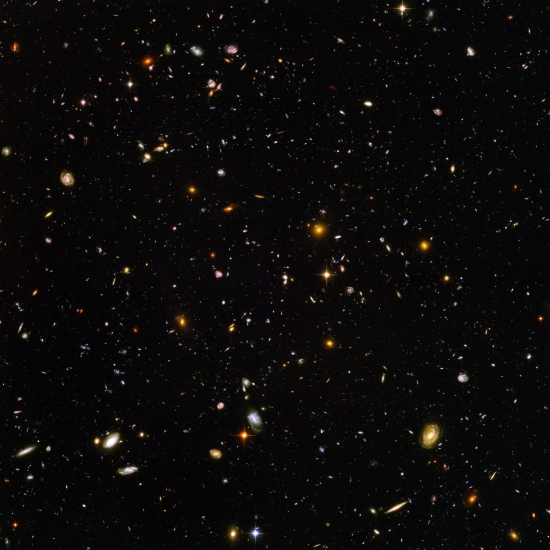
Image: The original NASA release image of the Hubble Ultra Deep Field, containing galaxies of various ages, sizes, shapes, and colors. The smallest, reddest galaxies, of which there are approximately 10,000, are some of the most distant galaxies to have been imaged by an optical telescope, probably existing shortly after the Big Bang. Credit: NASA/ESA.
I immediately thought of a Brian Aldiss title when I first saw the HUDF: Galaxies Like Grains of Sand came out in 1960, a collection of previously published stories later linked into a kind of future history. The grains of sand analogy always captures the imagination — most of us have walked on beaches. But here all sense of scale seems to drop away.
Sara Seager commented in her powerful The Smallest Lights in the Universe (2020) that with the original Hubble Deep Field, Robert Williams, then director of the Space Telescope Science Institute, had “…revealed three thousand previously unseen points of light. Not three thousand new stars. Three thousand new galaxies. Bob Williams almost single-handedly discovered millions of billions of possible worlds.”
How many planets are there around stars in the visible universe? How many galaxies? Astronomers and mathematicians work routinely with the kind of numbers involved here, but for us civilians, I don’t think it’s possible to emotionally comprehend such immensity. The Hubble Deep UV (HDUV) Legacy Survey image, released in 2015, ups the catch to 15,000 galaxies.
Tiny lights in the sky dwarf us whether they are stars or galaxies. It was imagery from TESS, our Transiting Exoplanet Survey Satellite, that brought on these reflections. Have a look at the starfield below. TESS has discovered 74 planets at this point, with another 1200 awaiting confirmation in an ongoing mission to examine nearby stars. The field of view is 400 times larger than what Kepler could cover in its tight stare in the direction of Cygnus and Lyra, but both missions rely on the transit method, detecting the presence of a planet crossing in front of its star in the stellar lightcurve. We’re going to get a lot of planets out of TESS, but among the targeted, nearby stars, probably around 1200 to 1500.
Stars like grains of sand. Here we’re looking toward Cygnus, back in Kepler country, and the sky is a glory of objects even if TESS will have a gap in coverage in the northern hemisphere, given an attempt by the science team to minimize the effects of scattered light from the Earth and the Moon. A mosaic of the southern coverage takes in more sky.
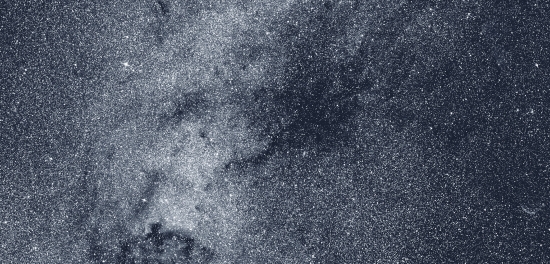
Image: This detail of the TESS northern panorama features a region in the constellation Cygnus. At center, the sprawling dark nebula Le Gentil 3, a vast cloud of interstellar dust, obscures the light of more distant stars. A prominent tendril extending to the lower left points toward the bright North America Nebula, glowing gas so named for its resemblance to the continent. Credit: NASA/MIT/TESS and Ethan Kruse (USRA).
The TESS numbers are already robust, with each of 13 northern hemisphere sectors imaged for nearly a month with four cameras, each of the latter with 16 charge-coupled devices (CCD). That adds up to 38,000 full science images for each of the CCDs, a total of 40 terabytes of data. It’s exhilarating to realize that these numbers are about to jump as TESS goes into its extended mission, revisiting the southern sky for another year, while relying upon improvements in data collection and processing that will return full-sector images every 10 minutes, as opposed to the earlier 30. TESS measures tens of thousands of stars, says NASA, every two minutes.
“These changes promise to make TESS’s extended mission even more fruitful,” said Padi Boyd, the mission’s project scientist at NASA’s Goddard Space Flight Center in Greenbelt, Maryland. “Making high-precision measurements of stellar brightness at these frequencies makes TESS an extraordinary new resource for studying flaring and pulsating stars and other transient phenomena, as well as for exploring the science of transiting exoplanets.”
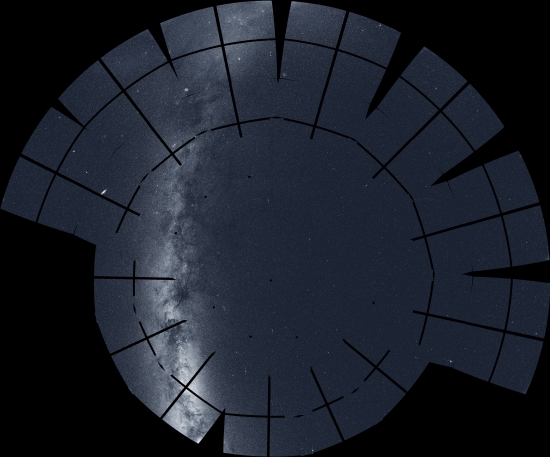
Image: This mosaic of the northern sky incorporates 208 images taken by NASA’s Transiting Exoplanet Survey Satellite (TESS) during its second year of science operations, completed in July 2020. The mission split the northern sky into 13 sectors, each of which was imaged for nearly a month by the spacecraft’s four cameras. Among the many notable celestial objects visible: the glowing arc and obscuring dust clouds of the Milky Way (left), our home galaxy seen edgewise; the Andromeda galaxy (oval, center left), our nearest large galactic neighbor located 2.5 million light-years away; and the North America Nebula (lower left), part of a stellar factory complex 1,700 light-years away. The prominent dark lines are gaps between the detectors in TESS’s camera system. Credit: NASA/MIT/TESS and Ethan Kruse (USRA).
Does anyone ever get jaded with the sheer numbers we talk about as we delve into the cosmos? I suppose a kind of workaday numbness may occasionally settle in, and I suppose it would happen as well to geologists, for example, when trying to wrap their heads around the deep time suggested by the varied strata that first gave scientists a glimpse of how old the Earth really was. I just finished reading Hugh Raffles’ extraordinary The Book of Unconformities, a startling look not only into deep time but the landscape of loss as Raffles confronts twin deaths in his family that came seemingly out of nowhere. All of this against the background of stone considered at geologically significant sites. A taste of this:
At Siccar Point on the east coast of Scotland, a path leads precipitously down the cliff to Hutton’s Unconformity, the line of contact between the two rocks that James Hutton showed the mathematician John Playfair and the experimental geologist Sir James Hall on that memorable June day in 1788. It’s the physical proof of a gap in time, in this case the gap between the Silurian graywackes that formed 440 million years ago on the seafloor at the margins of the Iapetus Ocean (ancient ocean of the Southern Hemisphere) and were forced upward as the vast water body closed, and the Devonian Old Red Sandstone that was laid down on their eroded surface sixty-five million years later by rivers flowing into what was then most likely a tropical floodplain.
Thus modern geology was born. Hutton found in Siccar Point layered sandstone pierced by gray metamorphic rock that would confirm his belief that the Earth was far older than European natural scientists had ever expected. Playfair would later write: “The mind seemed to grow giddy by looking so far back into the abyss of time; and whilst we listened with earnestness and admiration to the philosopher who was now unfolding to us the order and series of these wonderful events.”
There should be a word that signifies the mind all but buckling with the wild surmise of the scale of things. In the late 18th Century, a notion of the ‘sublime’ began to re-emerge in European thought, one suggested by the grandeur of jagged alpine landscapes, for example, but today’s usage of the word doesn’t take in the aspect of dislocation, even disorientation, that such landscapes were freighted with back then, mingling with profundity. Go back to that earlier usage, though, and I’ll maybe opt for ‘sublime’ as the right word to suggest my own response to such imagery.

Kuiper Belt Oddity? Explaining Arrokoth’s Shape
Now and then people mention that our Pioneers and Voyagers made it through the Kuiper Belt on their long journey toward system’s edge, though unfortunately without operational cameras to record what they saw. A missed opportunity? Not really. Think about how long it took to find a Kuiper Belt Object like Arrokoth, the first one ever seen close up thanks to the mighty work of the New Horizons team. Without a major search to find a target, a craft passing through the Kuiper Belt is almost certainly going to encounter no objects whatsoever within range to record the details.
For now, Arrokoth, the object once known as Ultima Thule before running afoul of our times, has to serve as our example of what can emerge in this distant region, and an odd object it is. When its shape is compared to a flattened snowman, as it often is, the real story is in the word ‘flattened.’ How does this roughly 30-kilometer object emerge in the shape it’s in, and under what conditions was it spawned out there in its 298 year orbit around the Sun?
Two connected lobes are involved, as the famous image below makes clear, making this an evident contact binary, where two formerly discrete objects nudged into each other at low velocity. That part of the origin story is easy, and in fact the bi-lobed shape is not unique. We can find it in certain comets as well — consider 67P/Churyumov-Gerasimenko.
But both lobes of Arrokoth are flattened, not just one. A new paper in Nature Astronomy goes to work on the question of how this happened. Ladislav Rezac (Max Planck Institute for Solar System Research), one of the two first authors of the paper, comments:
“We like to think of the Kuiper Belt as a region where time has more or less stood still since the birth of the Solar System. There is as yet no explanation as to how a body as flat as Arrokoth could emerge from this process.”
Exactly so, because four billion kilometers out from the Sun, KBOs should have remained largely unchanged, frozen into their form in ways that give us information about that era. Yet here we have Arrokoth, whose surface seems smooth, uncratered, and again, flat. Is this shape primordial, or are we actually looking at an evolution of a cold classical Kuiper Belt Object that should have formed where we observe it today?

Image: Arrokoth’s flattened shape can only be seen from a certain perspective. The first images returned by NASA’s New Horizons spacecraft gave the impression of a “normal” snowman-shaped object. Arrokoth’s surface is surprisingly smooth and displays only few craters. Credit: © NASA/Johns Hopkins University Applied Physics Laboratory/Southwest Research Institute.
To get from there to here, Rezac and co-author Yuhui Zhao (Purple Mountain Observatory, Chinese Academy of Sciences) ran a ‘mass-loss-driven shape evolution model’ called MONET that suggests a process driving the answer, one developed in another paper earlier this year (citation below).
At the heart of the discussion is Arraokoth’s rotational axis, which is close to alignment with the orbital plane; the obliquity is about 99°. One polar region faces the Sun while the other faces away, while equatorial regions and the lower latitudes are dominated by daily variations in flux. The poles heat and release frozen gases, to produce a loss of mass which, the authors argue, produces the observed flattening over time. Thus “…the polar regions reach higher peak temperatures than the equator, due to the fact that the thermal timescales are longer than the rotational timescales, and the poles experience more sublimation than the equatorial regions.”
We wind up with symmetric erosion between northern and southern hemispheres. The process is thought to have occurred early on, perhaps in 1 to 100 million years, as volatile ices sublimated. The authors assume methane as the driving volatile for the evolution of Arrakoth’s precursor body, but add that N2, CO and CH4 ices all show active sublimation and condensation on large KBOs.
The escape of volatiles early in the formation process would not be particularly surprising, in comparison to what New Horizons found at Pluto, where larger size and stronger gravity allowed the dwarf planet to retain carbon monoxide, nitrogen and methane gases to the present era. Small bodies like Arrokoth would hardly have the gravitational attraction to hold on to these volatiles. Moreover, this may be a common part of the evolution of Kuiper Belt Objects:
This process most likely occurred early in the evolution history of the body, during the presence of supervolatile ices in the near subsurface layers. This could be the dominant process shaping the structure of KBOs if there were no catastrophic collision reshaping the body in their later history. Furthermore, while cold classical KBOs reserve their shape sculptured by early out-gassing, the structure of Centaurs and Jupiter-family comets will be further modified by the same scenario once they enter their current orbit configuration from the Kuiper belt, under sublima- tion of different volatile species. We suggest that this mechanism should be taken into account in models studying planetesimal formation and the shape evolution of KBOs, as well as other small icy bodies in regions where supervolatile ices are expected to be present.
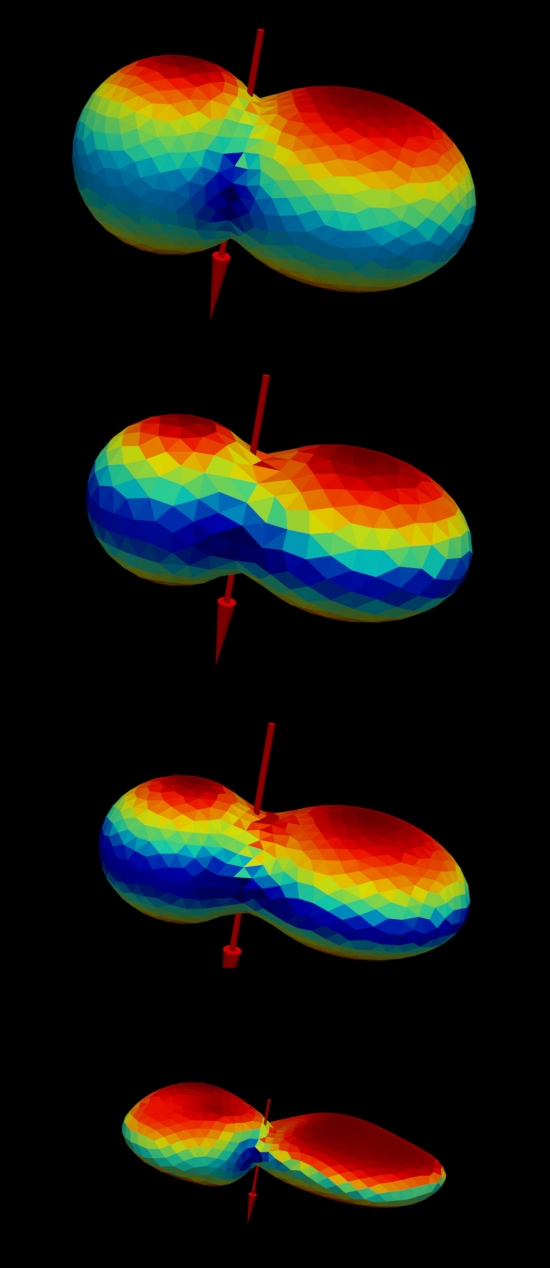
Image: Snapshots from numerical simulation of shape evolution of Arrokoth’s analogue due to sublimation driven mass loss. The bottom most shape is a digital terrain model derived from New Horizon observations. The color represents single orbit averaged temperatures. Red stands for warm and blue for cooler regions. Credit: © PMO/MPS.
The paper is Zhao, Rezac et al., “Sublimation as an effective mechanism for flattened lobes of (486958) Arrokoth,” Nature Astronomy 5 October 2020 (abstract). The earlier paper referenced above is Zhao et al., “The phenomenon of shape evolution from solar-driven outgassing for analogues of small Kuiper belt objects,” Monthly Notices of the Royal Astronomical Society 492, 5152-5166 (2020). Abstract.

The Best of All Possible Worlds
I’ve always loved the notion of ‘superhabitability,’ which forces us to ask whether, in our search for planets like the Earth, we may in our anthropocentric way be assuming that our own planet is a kind of ideal. Some scientists have been asking for years whether it is possible that the Earth is not as ‘habitable’ as it might be (see What Makes a Planet ‘Superhabitable’?). The question then becomes: What factors would make a planet a better place for life than our own?
Now Dirk Schulze-Makuch (Washington State University), working with René Heller (Max Planck Institute for Solar System Research, Göttingen) and Edward Guinan (Villanova University) runs through the characteristics of superhabitability, which take in planets that are a bit warmer than ours, a bit larger, and somewhat wetter, not to mention those that circle stars that live longer than our G-class Sun. 24 interesting planets emerge, all more than 100 light years out, but none of those so far identified meet all the specifications for superhabitability enumerated in the paper, nor could they, given the limitations on our current observing methods.
As we dig into this, let’s first remember the significance of target selection as we continue to refine our telescopes. With interesting new resources coming, space observatories like the James Webb Space Telescope and the European Space Agency’s PLATO, we will delve ever more deeply into exoplanet atmospheres.The goal here is to consider the star systems we will want to investigate as we learn how habitability works and how it might be improved upon. Choosing the list carefully is paramount, for time on these observatories will be precious.
We’ve talked before about the virtues of K-class stars, which are less massive and less luminous than the Sun, while also offering a more capacious lifetime, at minimum twice that of a typical G-class star, and in some cases quite a bit longer than that. Given that life on Earth will likely be rendered impossible within a billion years or so due to changes on the Sun, how much more useful to have tens of billions of years longer to allow life to grow and advance. Various other factors likewise come into play, among them a planet’s geothermal heat and magnetic field. The paper runs through the possibilities (and you might also want to have a look at Orange Dwarfs: ‘Goldilocks’ Stars for Life?, which contains several further citations). From the paper:
…studies of solar proxies of our Sun have shown that young dG [dwarfs of spectral class G] stars rotate > 10 times faster than dG stars near the age of our Sun, and have correspondingly high levels of magnetic dynamo-driven activity and very intense coronal X-ray and chromospheric FUV emissions (Guinan et al., 2005), which makes the origin and early evolution of life challenging. Heller and Armstrong (2014) argued that the increased life span of stars with masses lower than one solar mass may allow inhabited planets to build up a higher biodiversity and possibly even a more complex ecosystem…. This argument would lift K- and M-dwarf stars into the realm of superhabitable planet host stars.
But as the authors point out, moving the range of superhabitability into the realm of M-dwarfs is going too far — here we confront problems of tidal locking, flare activity and atmospheric loss due to the proximity of the planet to the star and exposure to a strong stellar wind. Avi Loeb and Manasvi Lingam have also written on the likelihood that K-dwarfs offer the most stable long-lived environment conducive to superhabitability, and it is worth remembering that we have a K-dwarf in the closest stellar system to our own, Centauri B in Alpha Centauri.
What would a superhabitable planet look like? A planet a bit larger than Earth — one with, say, 1.5 times Earth’s mass — would retain internal heating from radioactive decay longer, while the stronger gravity would allow the planet’s atmosphere to be retained for a longer period. A planet between 5 and 8 billion years old seems to be optimum, an age at which geothermal heat and protective magnetic fields persist. Temperature is also an interesting factor:
…higher temperatures than currently existing on Earth seem to be more favorable. The caveat is that the necessary moisture has to be available as well because inland deserts with low biomass and biodiversity are also common on our planet. One example is the early Carboniferous period, which was warmer and wetter (Raymond, 1985; Bardossy, 1994) on our planet than today, with so much biomass produced that we still harvest the organic deposits in the form of coal, oil, and natural gas from it. Thus, a slightly higher temperature, perhaps by 5°C—similar to that of the early Carboniferous time period—would provide more habitable conditions until some optimum is reached. However, this will depend on the biochemistry and physiology of the inhabiting organisms and the amount of water present.
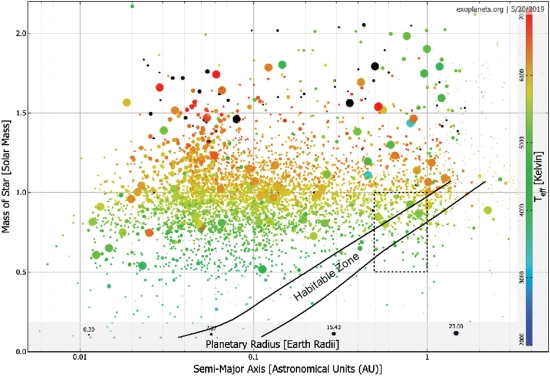
Image: This is Figure 1 from the paper. Caption: Star-planet distances (along the abscissa) and mass of the host star (along the ordinate) of roughly 4500 extrasolar planet and extrasolar planet candidates. The temperatures of the stars are indicated with symbol colors (see color bar). Planetary radii are encoded in the symbol sizes (see size scale at the bottom). The conservative habitable zone, defined by the moist-greenhouse and the maximum greenhouse limits (Kopparapu et al., 2013) is outlined with black solid lines. Stellar luminosities required for the parameterization of these limits were taken from Baraffe et al. (2015) as a function of mass as shown along the ordinate of the diagram. The dashed box refers to the region shown in Fig. 2. Data from exoplanets.org as of May 20, 2019. Color images are available online.
Here is the complete list of factors that lead to superhabitability as listed in the paper. 9 of the 24 planets identified orbit K stars, while 16 of them are between 5 and 8 billion years old. None of these worlds meet all the criteria, in any case. To be fully identified as superhabitable, a planet would meet the following benchmarks:
- In orbit around a K dwarf star
- About 5-8 billion years old
- Up to1.5 more massive than Earth and about 10% larger than Earth
- Mean surface temperature about 5°C higher than on Earth
- Moist atmosphere with 25-30% O2 levels, the rest mostly inert gases (e.g., N2)
- Scattered land/water distributed with lots of shallow water areas and archipelagos
- Large moon (1-10% of the planetary mass) at moderate distance (10-100 planetary radii)
- Has plate tectonics or similar geological/geochemical recycling mechanism as well as a strong protective geomagnetic field
As I mentioned, none of the planets of interest identified in this paper is known to have all these characteristics, but we have to keep in mind “the uncertainties in our mostly qualitative model and…the uncertainties in the observed parameters” as we examine the list. Moreover, only two of these — Kepler 1126 b and Kepler-69c — have been validated; the others continue to be planet candidates (Kepler Objects of Interest, or KOIs), and some may turn out to be false positives, while one of the confirmed worlds, Kepler-69c is, at almost 2000 light years, too far out to be a promising candidate for JWST, or even possible successors like LUVOIR.
The near-term question arising from this initial cut at superhabitability is whether we can use these criteria to find worlds closer than 100 light years, and thus accessible for high-quality observations from the TESS mission. The list of criteria presented here should help to establish observing priority for any worlds meeting a large number of these standards that can be identified in this distance range, making them high-value targets for investigating biosignatures.
The paper is Schulze-Makuch, Heller & Guinan, “In Search for a Planet Better than Earth: Top Contenders for a Superhabitable World,” Astrobiology 18 September 2020 (full text). The Lingam & Loeb paper is “Physical Constraints on the likelihood of life on exoplanets,” International Journal of Astrobiology Vol. 17, No. 2 (April, 2018), 116-126 (abstract), but see also the same authors’ later paper “Is life most likely around Sun-like stars?,” Journal of Cosmology and Astroparticle Physics Vol. 2018, May 2018 (abstract). Citations to earlier work from René Heller and colleagues on the question of superhabitability can be found in the Centauri Dreams stories I linked to above.

Dark Skies: Space Expansionism, Planetary Geopolitics, and the Ends of Humanity: A Review
While we often discuss expansion into the Solar System as a step leading to interstellar flight, the movement into space has its dark side, as author Daniel Deudney argues in a new book. As Kenneth Roy points out in the review that follows, it behooves everyone involved in space studies to understand what the counter-arguments are. Ken is a newly retired professional engineer who is currently living amidst, as he puts it, “the relics of the Manhattan Project in Oak Ridge, Tennessee.” His professional career involved working for various Department of Energy (DOE) contractors in the fields of fire protection and nuclear safety. As a long-time hobby, he has been working with the idea of terraforming, which he extended to the invention of the “Shell Worlds” concept as a way to terraform planets and large moons well outside a star’s ‘Goldilocks’ zone [see Terraforming: Enter the Shell World].
In 1997, Ken made the cover of the prestigious Proceedings of the U.S. Naval Institute for his forecast of anti-ship, space-based, kinetic energy weapons. With his co-authors R.G. Kennedy and D.E. Fields, he has appeared multiple times in JBIS and Acta Astronautica with papers on terraforming and space colonization. He is a founding member of the not-for-profit corporation Tennessee Valley Interstellar Workshop (TVIW), now operating as the Interstellar Research Group, and remains active in that organization. A graduate of the Illinois Institute of Technology and the University of Tennessee at Knoxville in engineering, Ken tells me he enjoys reading science fiction, history, alternative history, military history, and books on space colonization and terraforming.
Dark Skies: Space Expansionism, Planetary Geopolitics, and the Ends of Humanity, by Daniel Deudney (Oxford University Press, 2020).
A review by Kenneth Roy
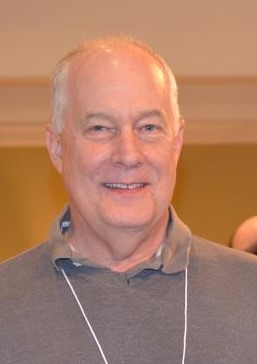
Professor Deudney teaches political science, international relations, and political theory at Johns Hopkins University. His book can be difficult to read, in large part due to the academic writing style. Although there are a number of interesting arguments in the book, the lack of clarity and conciseness make them somewhat difficult to access. Once you get past the writing style, Deudney argues that humanity’s expansion into space will decrease the probability of human survival. Deudney raises some good questions relative to the future of Earth and actually makes a few good points applicable to humanity’s expansion into the solar system and beyond. Science fiction readers and space enthusiasts will not enjoy this book, but it is important that we try to understand and evaluate Deudney’s arguments, rather than dismiss them out of hand. You should appreciate your enemies; they will point out things that your friends and allies will never mention, things that you probably need to know.
Prometheans argue that scientific and technological advances allow for the total transformation of the human condition, a realization of utopia, with material abundance and even individual immortality. Starting with the industrial revolution, this trajectory seems to be leading to a very positive future for humanity. But around the mid-twentieth century a number of concerns surfaced suggesting a much more pessimistic end to the Promethean vision. The concerns include nuclear and biological weapons, genetic engineering, artificial intelligence, environmental collapse, and even new forms of despotism based on advanced surveillance and coercion technologies. But all technology is always a two-edged sword capable of great good and great harm depending on the intentions and even wisdom of the humans that utilize them. This is this dilemma on which Dr. Deudney bases his central argument. He seems to suggest that because the sword can indeed harm the owner, perhaps he is better off without it. Or if he absolutely must have a sword, he should made it as harmless as possible. He argues that humanity should be able to discern which technologies offer more risk than reward and should thus be proscribed while pursing technologies and policies that offer great reward for only minor risk. He argues that colonization of space and the exploitation of space-based resources belongs in the former category and should be prohibited.
But Deudney isn’t entirely anti-space. He advocates Earth-centered space activities focused on nuclear security and environmental protection. He is okay with communication and weather satellites. He believes that space activities should be used to protected the Earth rather than expand the militarization and colonization of space.
Advocates of humans expanding into space and exploiting the resources there Deudney terms “space expansionists.” He describes space expansionism as a “complex and captivating ideology…that extrapolates and amplifies the Promethean worldview of technological modernism into a project of literally cosmic scope.” He considers space expansionism to be a science-based and technology dependent religion. Space expansionists advocate for human expansion into space and believe that such expansion is desirable both for those lucky enough to work and live in space but also for humanity in general and the Earth in particular. According to Deudney, space expansionists promise humanity a permanent final frontier, as well as knowledge, and material and energy resources almost beyond measure that can help address Earth’s environmental problems. Deudney disagrees and offers a number of arguments that are discussed below.
Two worrisome technologies that Deudney identifies as being advocated by space expansionists are genetic and cybernetic technologies. The first is also termed transhumanism or the improvement of human beings through genetic manipulation. The second is machine enhancement of human bodies and minds or possibly complete replacement of humans with machines with greater intellectual and physical capability. These two developing technologies do indeed pose many ethical questions. They would be useful but not necessary for successful expansion of humanity into space. But even if the human (or transhuman or cybernetic) expansion into space were to be completely banned, the issue does not go away. The transhumanism movement and the development of cybernetic technology will proceed on Earth completely independent of space activities. There is simply too much advantage to be had for those who possess it. Humans of 2020 are not the final evolutional product and Nietzsche’s ubermensch (or Star Trek‘s Khan Noonien Sing and his augments) pose important ethical and even existential problems. But these technologies will not be avoided by restricting space expansionism.
A third technology that worries Deudney is nanotechnology. This technology enables construction of materials and machines from basic molecules. The big fear of nanotechnology is the construction of tiny machines that disassemble anything and everything they encounter and use the resulting molecules to make more of themselves, without end, until the entire planet is covered with them. This is known as the ‘gray goo’ scenario and it terminates humanity and indeed all life on the Earth. But nanotechnology is actively being pursued by numerous companies and countries because it has such tremendous potential. Nanotechnology would be very useful for space development but again, not essential.
Artificial intelligence is yet another technology Deudney, and others, are very concerned about. It offers great promise and great peril. Again, because of the potential advantages, it will be developed, and while potentially very useful for space activities is not essential.
These four technologies are intertwined, very powerful, and very dangerous. But because they are potentially so valuable, and so useful, they will be developed by someone at some point. Deudney’s fear that space expansion will accelerate their development, while possibly true, is irrelevant. They will be developed, unless a totalitarian world government using advanced surveillance and coercive technologies prevents it. In that case, the cure would be bad. Very bad, but in this particular case perhaps not as bad as the disease. Deudney fails to recognize that space expansionism offers some prospects for mitigating the risks of these technologies by allowing them to be developed in space at isolated research facilities that can be obliterated should something dangerous escape.
Deudney spends some time discussing the militarization of space. He seems to have associated nuclear-tipped missiles and the resulting nuclear annihilation risk with space expansionism simply because such weapons of mass destruction travel through space and can arrive at any point on earth minutes after launch. He doesn’t acknowledge that the first nuclear weapons were delivered by piston engine aircraft and that today hypersonic cruise missiles can deliver such warheads just fine without going into space. The Russians have nuclear-tipped torpedoes capable of destroying large harbors. Squashing the dreams of space expansionists will not in any way reduce the threat of nuclear war, and can arguably increase it due to resource depletion with increasing population pressures. Ronald Reagan’s Star Wars initiative was actually intended to prevent nuclear weapons from traveling through space, but Deudney views this effort as simply another effort at the militarization of space and thus something to be resisted.
Space (including Earth orbit) is currently effectively demilitarized. No nuclear weapons are stationed in space and no kinetic or beam weapon systems exist that can operate from space. Space technology offers the possibility of Earth orbit being filled with beneficial infrastructure such as communication, surveillance, weather, and positioning satellites, along with solar power stations and even some dirty industries. Deudney points out that with the ability to place this infrastructure in orbit comes the ability to place large weapon systems there as well. Orbital weapon systems would be capable of striking any point on Earth with nuclear, kinetic, or energy beam weapons within minutes of the decision to do so. It is the ultimate high ground and the nation that can achieve unchallenged military control of Earth orbit can dictate to the other nations of Earth, resulting in a de facto world government. But nuclear weapons can be delivered without having to travel through space, somewhat undermining Deudney’s argument.
While a world government would probably use space-based weapons to exert control over troublesome provinces, the argument that space-based weapons would lead to a world government is somewhat weak. The question of the desirability of a world government is very real but is effectively independent of the space colonization question. North Korea stands as a stark warning of what a world government might look like. Its citizens endure starvation and concentration camps while the rulers demand not just total compliance in all actions but sincere correct beliefs. Of course, the ruling elite will live very well indeed. And the North Korean political system cannot be overthrown from within. Only external forces. can remove the current system or force it to moderate its actions. A world government based on the North Korean model with advanced surveillance and coercive technologies would have no external threats to force it to moderate its actions or ever remove it from power. One possible exception to this is human colonies on Mars or in the asteroid belt. They might serve to act as the outside force keeping the world government in check, at least somewhat.
Asteroids are common throughout the solar system and occasionally will smash into Earth. Sometimes with negative consequences. Just ask the dinosaurs how that turned out for them. It has been said that asteroids are nature’s way of asking, “How is your space program coming?” Space expansionists claim asteroid protection as one reason to go into space in a big way: to protect the Earth. But Deudney points out that the ability to deflect an asteroid also implies the ability to direct an asteroid to a specific destination. With such an ability in the wrong hands this actually increases the probability of a massive asteroid impact with Earth, rather than reducing it.
Deudney suggests that space settlements have a dark side. The term space settlements as used by Deudney includes lunar colonies, artificial space habitats (O’Neil cylinders, Stanford tori, Bernal spheres, etc), asteroid settlements, and terraformed worlds. Building space settlements involves material engineering and high energies suitable for warfare. This represents a variant of the asteroid problem: in the wrong hands, this technology could do terrible things.
Terraforming is the transformation of a planet, such as Mars or Venus, to resemble the Earth and support human and other Earth life forms. Terraforming requires high energies, long time periods, and the transport of large masses around a solar system. Deudney points out that the ability to make a dead planet live also implies the ability to make a living world sterile.
In addition, space settlements individually will contain thousands, or at most a few million individuals. The life support systems and structural integrity are fragile things requiring a high degree of trust and/or control of the population to identify and remove unstable or dangerous individuals. Rather than being islands of freedom, space settlements could become, and maybe must become, micro-totalitarian states. And like the Greek city states of antiquity, they may find reasons to war amongst themselves, and perhaps with Earth. And they will war with weapons far deadlier than anything carried by the Greeks.
As space settlements are built further and further out into the outer edges of the solar system, perhaps around gas giants and their moons, they become isolated. Over time, humanity could branch into new species, perhaps unable to breed with each other. Rather than encounter aliens, we will create them. With the aid of genetic engineering and cybernetics, discussed above, this divergence could occur relatively quickly. Even with the Central Earth government and most space settlements agreeing to forgo genetic engineering and cybernetic modification of humans, it only takes one isolated space settlement to pursue this line of research to produce something quite alien and perhaps anti-human.
To the best of my ability, I have tried to identify and list here all arguments that Deudney has identified as reasons that space expansionism can decrease the probability of humanity’s survival. Many of his issues are indeed existential threats to humanity but not because of what the space expansionists propose. But they are deserving of serious consideration. These include genetic engineering, cybernetics, nanotechnology, and AI. They are real threats but also real opportunities.
Expanding into space places god-like destructive powers into the hands of those moving asteroids or large mass space freighters. In all likelihood, propulsion systems will utilize fusion power of some type, again giving god-like destructive powers of a different nature. Interstellar missions will be capable of moving large masses at some percentage of the speed of light. Take a space shuttle, run it up to only10% the speed of light and you have a planet killer. We should ensure that individuals embarking on the interstellar missions have a deep respect for, and love of, Earth. How do we protect Earth from the even one slightly deranged or evil individual who has control of an asteroid (or starship) and can direct it at a target of his, or her, choice? Space expansionists need to address this question. Are we looking at a priest-hood type space patrol, or something else?
But perhaps the big takeaway from Deudney’s effort involves government and how humanity will choose to govern itself. Globalists view a single world government as a means to reduce violence and warfare on Earth, perhaps ending the existential thread of nuclear war once and for all. Others view a single world government as a threat to freedom and a short journey to a totalitarian nightmare. But can a single world government control a solar system with dozens of lunar settlements, thousands of asteroid settlements, perhaps a couple of terraformed planets each with a growing population in the millions or even billions, and thousands of space settlements, some of which exist in the Oort cloud? Then add in genetic engineering, cybernetics, and AI, and you have something new in human experience. How is conflict resolved? Are there indeed dangerous technologies that should be proscribed, and if so, how is that done? How does all of this relate to the Fermi Paradox? Once interstellar missions are underway, the questions only multiply. It is unclear what the answer is to this problem, which does not mean that there is no solution. The space expansionist’s dreams face countless problems and this needs to be added to the list.
Deudney perhaps overstates his case and many of his arguments are flawed, but he does raise some valid points. Points that space expansionists need to address. Looking into the future, questions of how humanity deals with Star Trek‘s Khan Noonien Sing and his augments (or if you like, Nietzsche’s ubermensch) are very real and very important but separate from the space expansion question.
Deudney is also correct in that Earth is vital to future human expansion into the solar system and must be preserved at all costs. Space settlements and asteroid settlements will probably depend on living systems that must be renewed periodically by importing plants and animals and bacteria and viruses from Earth. Terraforming planets depends on life from Earth and even space settlements and terraforming efforts around distant stars will depend on life imported from Earth. Earth must be preserved for space expansionists to realize their visions.
The Universe has a number of methods available to it to sterilize entire planets. Deudney mentions asteroid impacts. He doesn’t address gamma ray bursts (GRBs). If we can deal with the unstable or evil individual problem, then space expansionists can protect Earth from asteroids and comets, and even the occasional runaway space freighter. But GRBs arrive with little warning and can irradiate Earth and other terraformed planets with intense levels of gamma rays, destroying the ozone layer and leading to an environmental disaster with eventual mass extinctions. But space settlements can be built with very heavy shielding and have no ozone problem. They could survive a GRB far better than a planet. Space-based colonies could then render aid to Earth, repairing the ozone layer and restoring the biosphere using techniques developed for terraforming.
Yes, Deudney is correct, the dreams of the space expansionists represent a two-edged sword for humanity. But sometimes a sharp sword is all that stands between you and eternal darkness.

